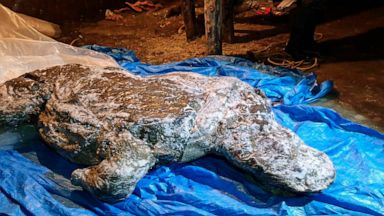A well-preserved Ice Age woolly rhino with many of its internal organs still intact has been recovered from permafrost in Russia’s extreme north.
Russian media reported Wednesday that the carcass was revealed by melting permafrost in Yakutia in August. Scientists are waiting for ice roads in the Arctic region to become passable to deliver it to a lab for studies next month.
It’s among the best-preserved specimens of the Ice Age animal found to date. The carcass has most of its soft tissues still intact, including part of the intestines, thick hair and a lump of fat. Its horn was found next to it.
Recent years have seen major discoveries of mammoths, woolly rhinos, Ice Age foal, and cave lion cubs as the permafrost increasingly melts across vast areas of Siberia because of global warming.
Yakutia 24 TV quoted Valery Plotnikov, a paleontologist with the regional branch of the Russian Academy of Sciences, as saying the woolly rhino was likely 3- or 4-years-old when it died.
Plotnikov said the young rhino likely drowned.
Scientists dated the carcass as anywhere from 20,000- to 50,000-years-old. More precise dating will be possible once it is delivered to a lab for radiocarbon studies.
The carcass was found on the bank of the Tirekhtyakh river in the Abyisk district, close to the area where another young woolly rhino was recovered in 2014. Researchers dated that specimen, which they called Sasha, at 34,000 years old.
Perfectly preserved head of Ice Age wolf found in Siberia
2020 The Associated Press. All rights reserved. This material may not be published, broadcast, rewritten or redistributed without permission.
Citation:
Well-preserved Ice Age woolly rhino found in Siberia (2020, December 31)
retrieved 31 December 2020
from https://phys.org/news/2020-12-well-preserved-ice-age-woolly-rhino.html
This document is subject to copyright. Apart from any fair dealing for the purpose of private study or research, no
part may be reproduced without the written permission. The content is provided for information purposes only.



